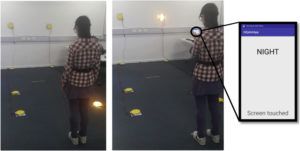Research by the Queensland University of Technology (QUT) in Australia has shown that flashing LED lights embedded in footpaths can break the ‘smartphone spell’ and alert ‘distracted walkers’ as they approach a road or rail intersection.
Mobile phone distraction is a global road safety concern, but most research and safety campaigns have so far focused on distracted driving. Some jurisdictions worldwide are now trialling footpath warning lights at busy intersections including cities in the Netherlands, Germany, Singapore and New Zealand, and also Sydney and Melbourne in Australia. The Brisbane study is the first of its type to evaluate whether or not flashing LED lights at ground level actually caught the attention of pedestrians looking down at their phones. The new QUT study was funded by the Australasian Centre for Rail Innovation, and KiwiRail also provided extensive in-kind support for the in-ground LED equipped pedestrian level crossings used in the study.
To find out how effective the LED technique is in actually capturing the attention of distracted walkers, researchers from QUT’s Centre for Accident Research and Road Safety-Queensland (CARRS-Q) brought 24 people (aged 20 to 43) into their Brisbane labs to assess their behaviour while using a phone. The subjects were fitted with eye trackers, handed a phone with a visually intensive task to perform, and asked to walk a ‘footpath’ with flashing ground-level LEDs (and some at eye level) and push a button whenever they noticed the lights.
“There are now growing concerns about ‘distracted walking’, particularly pedestrian distraction from looking down at mobile phones,” explained the QUT project’s chief investigator, Dr Gregoire Larue. “Existing studies have shown large numbers of pedestrians are distracted at intersections when crossing roads. These include one American study that showed 25% of pedestrians observed across 10 Manhattan intersections were distracted, either from talking on their phone, looking at their phone or using headphones. We also performed the same test with headphones and an auditory version of the task as listening to music and voices through headphones can also be distracting and reduces people’s ability to hear warnings.”
 Larue said, “The study found that participants used their peripheral vision to detect the flashing lights at ground level while doing a distracting task on their phone. Reaction time for ground lights (compared to eye level lights) improved by 159 milliseconds for lights one metre away, and 43 milliseconds for lights two metres away. It’s only a tiny amount of time but it can be the difference between life and death if you are crossing the road.”
Larue said, “The study found that participants used their peripheral vision to detect the flashing lights at ground level while doing a distracting task on their phone. Reaction time for ground lights (compared to eye level lights) improved by 159 milliseconds for lights one metre away, and 43 milliseconds for lights two metres away. It’s only a tiny amount of time but it can be the difference between life and death if you are crossing the road.”
Larue continued, “Ground level flashing lights were just as successful at catching their attention as face level lights are for people not on their phones. However, proximity is the key; the fastest response times happened when they were one metre from the lights. This is consistent with close-range peripheral vision and existing research that shows walkers tend to fixate on the ground around one or two steps ahead. Further research in the field is needed to see if the results are the same as in a laboratory setting.





